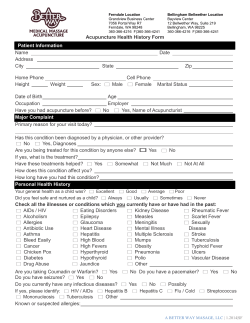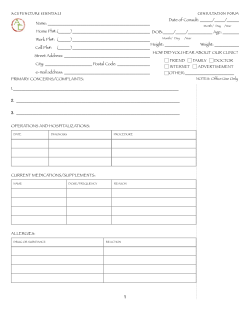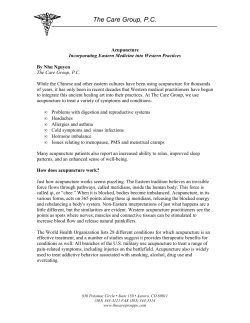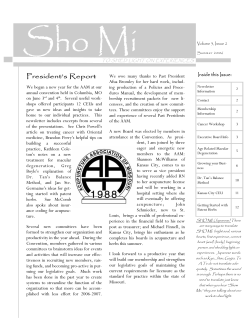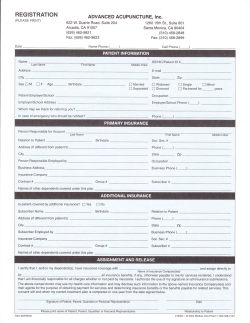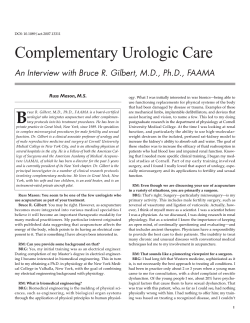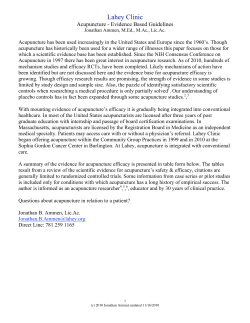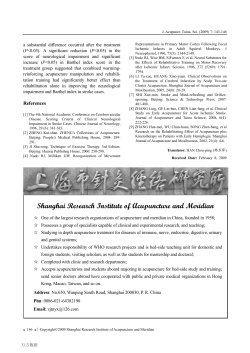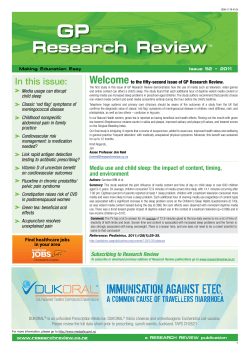
Document 21368
ACUPUNCTURE BOARD 444 North 3'd Street, Suite 260, Sacramento, CA 95811 Phone: (916) 445-3021 Fax: (916) 445-3015 www.acupuncture.ca.gov MEMORANDUM June 21, 2010 DATE I TO . Acupuncture Board members FROM SUBJECT Cathy Hardin Schau, Education Coordinator Follow-up site visit & program review: Nine Star University of Health . Sciences, Master of Science in Traditional Chinese Medicine (MSTCM) [ Program Application timeline & curriculum changes October 17, 2008: Application is received for the MSTCM program at NSUHS. The application specifically requires that course syllabi are submitted for each course offered in the training program however the material submitted by NSUHS included only a general descriptive paragraph for the program's courses, with several course descriptions missing. January 28, 2009: In response to a request for detailed course syllabi, NSUHS submits documentation for some of the courses offered. Based on the list of courses offered, thirteen syllabi are missing. April 20, 2009: In response to another request, the missing syllabi are submitted. April 28, 2009: I send NSUHS a detailed analysis ofthe curriculum requirement form that they submitted for their program. Based on the course syllabi received on January 28 and April 20, the training program is extremely deficient in almost every subject area. Additionally, the syllabi submitted do not contain sufficient detail to accurately describe the courses, and in many cases do not represent enough training material to justify the number of hours offered for a course. May 14, 2009: In response to the April 28 letter, NSUHS submits a curriculum requirement form and course syllabi for a second, entirely new program curriculum. July 14, 2009: I send NSUHS a letter noting that the new curriculum still does not meet the required number of instruction hours in the herbal medicine subject area. July 23, 2009: NSUHS submits an updated curriculum that includes an additional herbal training course. Page 1 of3 March 29, 2010: In response to concerns raised by Board members at the November 19,2009 meeting, NSUHS submits a curriculum requirement form and course syllabi for a third new program curriculum. April 27, 2010: I present a review of the third version ofNSUHS' program curriculum at the Board meeting. The new curriculum includes a number of deficiencies and areas of concern that are noted in the report. In response to this report, the Board requires that NSUHS submit final, accurate descriptions of the courses that make up the program's curriculum. May 11, 2010: A letter detailing the Board's decision is sent to NSUHS (Attachment 1). May 26, 2010: NSUHS submits a fourth, updated version of all of the courses offered in the program. They also notify the board that they hired Ronald Sokolsky as an "educational consultant" to complete the review and revision of the course syllabi. Review of Fourth Revised Curriculum • In the current, updated curriculum, the total number of training hours has decreased by 30, for a new total of 3,315 hours. • Due to this decrease of hours, the courses that meet the requirements of the Basic Sciences category, Section 1399.434(a), now total only 345 hours. This is 5 hours short of the required minimum of350 hours of instruction in this category. • The course outlines for AC 701-"Special Acupuncture Techniques" and HM 202-"Herbal Formulas II have not been updated from the previous versions. The outlines for these courses are identical, and include training in acupuncture needling and adjunctive techniques that are not typically seen in an herbal formulas course (Attachment 2). • Although the Course Description section ofthe syllabus for FD 106-"Nei Jing" was updated, the course outline remains unchanged from the previous version and is identical to the course outline for AC 601-"Acupuncture VI" (Attachment 3). • FD 561-"Clinical Medicine" is identified as fulfilling the following subject area: Clinical medicine - A survey of the clinical practice of medicine, osteopathy, dentistry, psychology, nursing, chiropractic, podiatry, naturopathy, and homeopathy to familiarize practitioners with the practices of other health care practitioners (Section 1399.434(c)(10)) The course outline for this course indicates that students wi11learn how to identify diseases, recognize which diagnostic tests are needed and whether to refer, and how to treat patients. However there is no indication that the course includes an overview of the therapeutic techniques practiced by the health care providers listed in the subject area requirement (Attachment 4). Page 2 of3 • None of the course outlines, the current catalog, or the clinic manual contains a requirement for students to complete a first aid and CPR course. Section 1399.434(f)(3) requires all training programs to include "a minimum of eight (8) hours in first-aid and adult/child cardiopulmonary resuscitation (CPR) from the American Red Cross, American Heart Association or other organization with an equivalent course approved by the board". Conclusions Despite the fact that NSUHS has now revised their curriculum three times, with feedback from the board each time regarding deficiencies, the training program offered at this school is not in full compliance with the Acupuncture Regulations. Additionally, these frequent changes to the training program curriculum will likely place a large burden on students currently enrolled in the program. More than half of the student body, or approximately 27 students, have been enrolled since 2008 or 2009, and have almost certainly completed some of the courses for which the curriculum has changed significantly at least once in the last 12 months. In many cases, these courses will not have been compliant in their previous form and students will have to retake courses in order to complete the CAB requirements. Based on the information provided by the school, there does not appear to have been sufficient improvement to the training program to warrant approval by the CAB. Page 3 of3 STATe OF CALIFORNIA ) 11\ I: AN! I c~ur~; ;UMI F-1 Sf-HVler. ~~ I\GLNL:Y • Af4NO!Il t:3CIIWAF-lZENCC:H.. "E:R, GOV! HNOR ACUPUNCTURE BOARD rd 444 North 3 Street, Suite 260, Sacramento, CA 95811 Phone: (916) 445-3021 Fax: (916) 445-3015 www.acupuncture.ca.gov Attachment 1 May 11, 2010 Philip Yang, President Nine Star University of Health Sciences 441 De Guigne Dr. #301 Sunnyvale, CA 94085 Dear Philip, As you know, at the May 6, 2010 board meeting the Acupuncture Board voted once again to postpone consideration of approval for the Master of Science in Traditional Chinese Medicine program offered at NSUHS. The Board's approved motion requires the school to submit final, accurate descriptions of the program curriculum, after which a new report will be presented to Board members for their consideration at the July 8th , 2010 meeting. Please provide the following to our office no later than May 21,2010: • Please review the curriculum syllabi that were submitted on March 29, 2010, and submit a letter verifying that all of the information contained on those syllabi is true and correct and accurately describes the courses that are taught at NSUHS. If you find that any syllabus does not accurately describe the course, please submit a corrected syllabus. • Please resubmit syllabi for the following courses: o All courses that include instruction in herbal medicine and botany o AC 301 - Acupuncture III o AC 501 - Acupuncture V o AC 701 - Special Acupuncture Technique o AC 601 - Acupuncture Theory Therapy o FD 106 - Nei Jing o FD 401 - TCM Internal Medicine I o FD 404 - TCM Internal Medicine II o FD 511 - Wen Bing o FD 512 - Classics IV Jin Kui (Golden Chamber) o FD 561 - Clinical Medicine o PH 402 - TCM Case Management I o PH 403 - Public Health o PH 404 - TCM Case Management II o PM 401 - Hygiene, Public Health & Epidemiology Again, please remember that a syllabus should be a complete and accurate description of all instruction that will occur during a course. The syllabus should detail everything that will be discussed during each course meeting and what, if any, homework will be assigned to students. If you have any further questions, please contact me at (916) 445-3021 or by email at cathy_hardin@dca.ca.gov. Sincerely, Cathy Hardin Schau Education Coordinator CKino OfJtar rztniPDrsitp tf~ OtJdonOdf 441 De GUigne Dr. #201, Sunnyvale, CA 94085 USA TEL: 408-532-5567 FAX: 408-733-3610 COURSE SYLLABUS 1. COURSE TITLE: SPECIAL ACUPUNCTURE TECHNIQUE 2. COURSE NUMBER: AC701 3. UNITS/HOURS: 3/45 4. INSTRUCTOR: a. Name: b. Office: c. Phone #: d. E-mail address: e. Office Hours: M-F, lOam-5 pm 5. DATE OF CLASS. TIME: "[Click here and type quarter,year]" , "[Click here and type hours]" 6. PREREQUISITES: AC501, AC601 7. LOCATION: Room # 1 Wan, Guo Z 11740 San Pablo Ave Suite A EI Cerrito, CA 94530 510-237-1619 8. COURSE DESCRIPTION: This course will re-enforce and delve more deeply into hygienic standards included in clean needle techniques, management of possible accidents in acupuncture treatment, equipment maintenance and safety and preparation for various needling techniques. Students will also practice the point location and the needling techniques for twelve primary channels and the Governor and Conception Vessel, while adhering to CNT protocols. 9. STUDENT LEARNING OUTCOMES: Outcome 2 Graduates demonstrate competency in the practice of Acupuncture and Oriental medicine. 2.1 Students will understand the concepts and theories of selected acupuncture techniques 2.2 Graduates will be able to perform AOM diagnostic methods and assessment criteria, and formulate, implement, monitor, and adapt treatment plans in a safe clinical environment. Outcome 3 Graduates demonstrate competencies in patient care in compliance with ethical. legal, and safety guidelines and communicate effectively in diverse settings. 3.1 Graduates will be able to identify medical emergency situations and conduct standardized procedures, including referrals to other primary healthcare professionals, emergency actions, and compliance with legal regulations. 10. PURPOSE OF COURSE: To teach students the Clean Needle Techniques and management of possible accidents in acupuncture treatment. To teach students how to select and competently use various techniques of acupuncture needling. To teach students how to locate and insert with confidence needles on the acupoints of the twelve primary channels including the Governor and Conception Vessel. 11. COURSE OBJECTIVES: a. To introduce and practice the clean needle techniques b. To indicate precaution and prevention of accidents in acupuncture treatment c. To demonstrate appropriate preparation for needling d. To practice various needling techniques e. To practice locating and inserting needles on the acupoints of the twelve primary channels 12. TEXTBOOKS: Required Textbooks: May 24,2010 1 dKino Of!Jtar rztniTlorsitp tfc:::IeMlth otJdOfltJ05 441 De GUigne Dr. #201, Sunnyvale, CA 94085 USA TEL: 408-532-5567 FAX: 408-733-3610 a. b. Cheng, X. (Eds.) (1999). Chinese Acupuncture and Moxibustion (New Essentials) (Revised Edition). Beijing, China: Foreign Languages Press. ISBN 7119017586 National Acupuncture Foundation, Sixth Edition (2009), Clean Needle Technique Manual for Acupuncturists, ISBN 978-0-9762537-3-0 Supplementary Reading: a. Shanghai College of Traditional Chinese Medicine (1981). Acupuncture,' A Comprehensive Text, Seattle, WA: Eastland Press. ISBN 0939616009 b. Deadman, P. & AI-Khafaji, M (1998). A Manual ofAcupuncture. East Sussex, England: Journal of Chinese Medicine. ISBN 0951054678 c. Maciocia, G. (1998). The Foundations ofChinese Medicine,' A Comprehensive Textfor Acupuncturists and Herbalists. New York: Churchill Livingstone. ISBN 0443039801 d. Nigel Wisemann (1991). Fundamentals of Chinese Acupuncture, Paradigm publication. ISBN 091211133x 13. Grading Scale: Superior Above Average Satisfactory Below Average Failure Incomplete Audit Letter Grade A A B+ B B C+ C C D+ D F I AU GPA 4.0 3.7 3.5 3.0 2.7 2.5 2.0 1.7 1.3 1.0 0.0 Numeric Value 94 -100 90 - 93.5 86 - 89.5 83 - 85.5 80 - 82.5 76 -79.5 73 -75.5 70-72.5 68 69.5 65 -67.5 Below 65 14. Course Requirements: Attendance Midterm Final Quizzes, Homework, Essays, Case Study, Presentation, and/or Reports, etc. TOTAL 5% 40% 40% 15% 100% 15. Academic Dishonesty: "Cheating and plagiarism will not be tolerated. If you are caught cheating or plagiarizing in any form, you will receive a failing grade for the course and be reported to the Academic Dean for appropriate disciplinary action." 16. Americans with Disabilities Act (ADA) Accommodation: : University is committed to providing reasonable academic accommodation to students with disabilities. The Academic Office along with each class and instructor will provide academic support services and specialized assistance to students with disabilities. Individuals with physical, perceptual, or learning disabilities as addressed by the Americans with Disabilities Act should contact the Student Services Director or the ADA Officer for information regarding accommodations. Please notify your instructor May 24,2010 2 CKine atJtar rztniPersitp tfc::IeMIth OfJd6It(J(!S 441 De Guigne Dr. #201, Sunnyvale, CA 94085 USA TEL: 408-532~5567 FAX: 408-733-3610 if you have filed and received ADA status so that reasonable efforts can be made to accommodate you. If you expect accommodation through the Act, you must make a formal request through Students Services Director or with the ADA officer. COURSE OUTLINE 1. CNT (clean needle techniques, refer to NCCA Manual): 1. Clean field 2. Hand Washing 3. Autoclave sterilization 4. Use of alcohol balls 5. Management of used cotton balls and local (point) cleaning 6. Handling and management of blood-stained cotton balls 7. Management of used needles 8. Precautions for preventing contamination 2. Filiform needle: 1. The structure and specification 2. Needling practice 3. Preparation prior to treatment 3. Needling methods: 1. Insertion 2. Angle and depth of insertion 3. Manipulations and arrival ofQi (Needling reaction) 4. Retaining and withdrawing the needle 5. Reinforcing and reducing methods 4. Description and Analysis of Ancient Acupuncture Techniques: 1. Standards of needling 2. Classification ofNeedling Methods in the "Inner Classics" 3. Needling Methods in the "Classic of Difficulty and Later Works" 4. Techniques of Moving the Qi, Strengthen and Draining the Qi. 5. Precautions, contraindications, and management of possible accidents in acupuncture treatment: 1. Precautions and contraindications in acupuncture treatment 2. Management of possible accidents (syncope or fainting, bent needle, broken needle, and struck needle 3. Equipment maintenance and safety 4. Yang Jizhou's twelve manipulations 6. Practice of acupuncture points (location and inserting): 1. Points on the Governor and Conception Vessels 2. Points on the Hand and Foot ofthe twelve Primary Channels WEEKLY SCHEDULE Week 1-3: May 24,2010 CNT (clean needle techniques, refer to NCCA Manual) - Clean field - Hand Washing - Autoclave sterilization - Use of alcohol balls - Management of used cotton balls and local (point) cleaning - Handling and management of blood-stained cotton balls 3 CJ<i1lB Ofltar rzl3niJ76rsitp tf~ O1jdenCdf 441 De Guigne Dr. #201, Sunnyvale, CA 94085 USA TEL: 408-532-5567 FAX: 408-733-3610 - Management of used needles - Precautions for preventing contamination Week4-7: Filiform needle: - The structure and specification - Needling practice - Preparation prior to treatment Needling methods - Insertion - Angle and depth of insertion - Manipulations and arrival ofQi (Needling reaction) - Retaining and withdrawing the needle - Reinforcing and reducing methods Description and Analysis of Ancient Acupuncture Techniques: WeekS Mid-Term Week 9: - Standards of needling - Classification of Needling Methods in the "Inner Classics" - Needling Methods in the "Classic of Difficulty and Later Works" - Techniques of Moving the Qi, Strengthen and Draining Precautions, contraindications 'and management ofpossible accidents in acupuncture treatment: - Precautions and contraindications in acupuncture treatment - Management ofpossible accidents (syncope or fainting, bent needle, broken needle, and struck needle - Equipment maintenance and safety - Yang Jizhou' twelve manipulations Week 10: Practice of acupuncture points (location and inserting): Points on the Governor Vessel and Conception Vessel Week 11: Points on the hand taiyin Lung channel and hand yangming Large Intestine channel Points on the foot yangming Stomach channel and foot taiyin Spleen channel Week 12: Points on the hand shaoyin Heart channel and hand taiyang Small Intestine channel. Week 13: Points on the foot taiyang Urinary Bladder and foot shaoyin Kidney Points on the hand shaoyang Triple Energizer and hand jueyin Pericardium Week 14: Points on the foot shaoyang Gall Bladder and footjueyin Liver Practical Review of Point Location Weekl5: Final-Exam May 24,2010 4 CKlno otJtar fUniPorsilp tfo1eoaIth GrJtJion(J(!f 441 De Guigne Dr. #201, Sunnyvale, CA 94085 USA TEL: 408-532-5567 FAX: 408-733-3610 COURSE SYLLABUS 1. COURSE TITLE: HERBAL FORMULA II 2. COURSE NUMBER: HM202 3. UNITS/HOURS: 4/60 4. INSTRUCTOR: a. Name: b. Office: c. Phone #: d. E-mail address: e. Office Hours: Fan, Xiu Zhen (Jenny) 1207 South Park Victoria blvd, Milpitas, CA 95035 408-935-8668 M-F; lOam-5pm 5. DATE OF CLASS, TIME: "[Click here and type quarter,year]" , "[Click here and type hours]" 6. PREREQUISITES: Upper Division Standing 7. LOCATION: Room # "[Click here and type Room#]" 4. COURSE DESCRIPTION: This course covers the hygienic standards including clean needle techniques, management of possible accidents in acupuncture treatment, equipment maintenance and safety and preparation for various needling techniques. Students practice the point location and the needling techniques for six channels (Urinary Bladder, Kidney, Pericardium, San Jiao, Gall Bladder, Liver channels) and the extraordinary points. Students also practice auricular, scalp, cutaneous, and warming acupuncture as well as electro-acupuncture, cupping, bledding, gua sha, dermal tacks and cold and heat therapy including moxibustion and ultrasound. Students practice acupuncture point stimulation devices including magnets and beads, too. 5. STUDENT LEARNING OUTCOMES: Outcome 2 Graduates demonstrate competency in the practice of Acupuncture and Oriental medicine. 2.1 Graduates will be able to explain the major concepts and theories of Acupuncture and Oriental medicine. 2.2 Graduates will be able to perform AOM diagnostic methods and assessment criteria, and formulate, implement, monitor, and adapt treatment plans. Outcome 3 Graduates demonstrate competencies in patient care in compliance with ethical, legal, and safety guidelines and communicate effectively in diverse settings. 3.1 Graduates will be able to identify medical emergency situations and conduct standardized procedures, including referrals to other primary healthcare professionals, emergency actions, and compliance with legal regulations. 6. PURPOSE OF COURSE: To teach students the Clean Needle Techniques and management of possible accidents in acupuncture treatment. To teach students a proper use of various techniques of acupuncture needles. To teach students how to locate and insert needles on the acupoints of the six channels and extraordinary acupoints. To teach ear and scalp acupuncture, cutaneous acupuncture, intradermal acupuncture, warming acupuncture, three-edged needle, electro-acupuncture, moxibustion, and cupping. 7. SPECIFIC OBJECTIVES: a. To introduce and practice the clean needle techniques b. To demonstrate appropriate preparation for needling c. To practice various needling techniques and other acupuncture techniques June 12,2010 1 &rinD OfJw ~niPOrsitp tf~ 0fJd6!ttJt1! 441 De Guigne Dr. #201, Sunnyvale, CA 94085 USA TEL: 408-532-5567 FAX: 408-733-3610 d. To indicate precaution and prevention of accidents in acupuncture treatment e. To practice locating and inserting needles on acupoints of the above six channels and the extraordinary points f. To practice ear and scalp acupuncture g. To practice moxibustion and cupping h. To practice three-edged needles i. To practice cutaneous needles j. To practice other acupuncture techniques 8. TEXTBOOKS: Required Textbooks: a. Cheng, X. (Eds.) (1999). Chinese Acupuncture and Moxibustion (New Essentials) (Revised Edition). Beijing, China: Foreign Languages Press. ISBN 7119017586 Supplementary Reading: a. Shanghai College of Traditional Chinese Medicine (1981). Acupuncture: A Comprehensive Text, Seattle, WA: Eastland Press. ISBN 0939616009 b. Deadman, P. & AI-Khafaji, M (1998). A Manual ofAcupuncture. East Sussex, England: Journal of Chinese Medicine. ISBN 0951054678 c. Maciocia, G. (1998). The Foundations ofChinese Medicine: A Comprehensive Textfor Acupuncturists and Herbalists. New York: Churchill Livingstone. ISBN 0443039801 d. Nigel Wisemann (1991). Fundamentals ofChinese Acupuncture, Paradigm publication. ISBN 09121l133x e. Chen Jing (1990). Anatomical Atlas ofChinese Acupuncture Points, Shangdong Science and technology Press. ISBN 7533101731 f. Paul Zmiewski (1989). Acumoxa therapy: Reference & Study Guide: Treatment ofDisease, Paradigm Pulications. ISBN 0912111224 9. GRADING SCALE: Superior Above Average Satisfactory Below Average Failure IncomJ!1ete Audit Letter Grade A A B+ B B C+ C C D+ D F I AU GPA 4.0 3.7 3.5 3.0 2.7 2.5 2.0 1.7 1.3 1.0 0.0 Numeric Value 94-100 90 - 93.5 86 - 89.5 83 85.5 80 - 82.5 76 -79.5 73 -75.5 70 -72.5 68 -69.5 65 -67.5 Below 65 10. COURSE REQUIREMENT: Attendance Midterm Final Quizzes, Homework, Essays, Case Study, Presentation, and/or Reports, etc. TOTAL June 12,2010 5% 40% 40% 15% 100% 2 &rinD O1Jtar rzJ3niPDrsilp tf~ OfJd(J//(J(Jf 441 De Guigne Dr. #201, Sunnyvale, CA 94085 USA TEL: 408-532-5567 FPIX.: 408-733-3610 11. Academic Dishonesty: "Cheating and plagiarism will not be tolerated. If you are caught cheating or plagiarizing in any form, you will receive a failing grade for the course and be reported to the Academic Dean for appropriate disciplinary action." 12. Americans with Disabilities Act (ADA) Accommodation: : University is committed to providing reasonable academic accommodation to students with disabilities. The Academic Office along with each class and instructor will provide academic support services and specialized assistance to students with disabilities. Individuals with physical, perceptual, or learning disabilities as addressed by the Americans with Disabilities Act should contact the Student Services Director or the ADA Officer for information regarding accommodations. Please notify your instructor if you have filed and received ADA status so that reasonable efforts can be made to accommodate you. If you expect accommodation through the Act, you must make a formal request through Students Services Director or with the ADA officer. COURSE OUTLINE 1. CNT (clean needle techniques, refer to NCCA Manual) 1. Clean field 2. Hand Washing 3. Autoclave sterilization 4. Use of alcohol balls 5. Management of used cotton balls and local (point) cleaning 6. Handling and management of blood-stained cotton balls 7. Management of used needles 8. Precautions for preventing contamination 2. Filiform needle: 1. The structure and specification 2. Needling practice 3. Preparation prior to treatment 3. Needling methods 1. Insertion 2. Angle and depth of insertion 3. Manipulations and arrival ofQi (Needling reaction) 4. Retaining and withdrawing the needle 5. Reinforcing and reducing methods 4. Precautions, contraindications, and management of possible accidents in acupuncture treatment: 1. Precautions and contraindications in acupuncture treatment 2. Management of possible accidents (syncope or fainting, bent needle, broken needle, and struck needle) 3. Yang Jizhou's twelve manipulations 5. Practice of acupuncture points (location and inserting): 1. Foot Taiyang Urinary Bladder channel 2. Foot Shaoyin Kidney channel 3. Hand Jueyin Pericardium channel 4. Hand Shaoyang Sanjiao channel 5. Foot Shaoyang Gallbladder channel 6. Foot Jueyin Liver channel 7. Extra points 6. Practice cupping and cold and heat therapy including moxibustion and ultrasound June 12,2010 3 &rino OfJtar rItniwrsilp tf~ 0fJtJi6ntJt1r 441 De Guigne Dr. #201, Sunnyvale, CA 94085 USA TEL: 408-532-5567 FAX: 408-733-3610 7. Practice Ear, Head, Three-edged needle (Bleeding), Cutaneous, Intradermal, Warming needle, and Electro Acupuncture, gua sha, dermal tacks, magents and beads WEEKLY SCHEDULE Weekl&2&3 CNT (clean needle techniques, refer to NCCA Manual) Clean field Hand Washing Autoclave sterilization Use of alcohol balls Management of used cotton balls and local (point) cleaning Handling and management of blood-stained cotton balls Management of used needles Precautions for preventing contamination Filiform needle: The structure and specification Needling practice Preparation prior to treatment Week4&5&6 Needling methods Insertion Angle and depth of insertion Manipulations and arrival ofQi (Needling reaction) Retaining and withdrawing the needle Reinforcing and reducing methods Precautions, contraindications and management of possible accidents in acupuncture treatment: Precautions and contraindications in acupuncture treatment Management ofpossible accidents (syncope or fainting, bent needle, broken needle, and struck needleO Yang Jizhou' twelve manipulations Week 7 Practice of acupuncture points (location and inserting): Foot Taiyang Urinary Bladder channel WeekS Mid- Term Exam Week 9 Continued Foot Taiyang Urinary Bladder Channel Week 10 Foot Shaoyin Kidney Channel Week 11 Hand Jueyin Pericardium channel Week 12 Hand Shaoyang Sanjiao channel June 12,2010 4 &riM 0fJ1dr rztf/iJ7ersitp l'~ OfJdtmCdf 441 De Guigne Dr. #201, Sunnyvale, CA 94085 USA TEL: 408-532-5567 FAX: 408-733-3610 Week 13 Foot Shaoyang Gallbladder channel Week 14 Foot Jueyin Liver channel Extra points Practice cupping and cold and heat therapy including moxibustion and ultrasound Practice Ear, Head, Three-edged needle (Bleeding), Cutaneous, Intradermal, Warming needle, and Electro Acupuncture, gua sha, dermal tacks, magents and beads Week 15 Final-Exam & Review HOMEWORK WeekI Preview and Review Week2 Preview and Review Week3 Preview and Review Week4 Preview and Review WeekS Preview and Review Week6 Preview and Review Week7 Preview and Review WeekS Midterm Exam Week9 Preview and Review WeekI 0 Preview and Review Weekll Preview and Review Weekl2 Preview and Review Week13 Preview and Review Weekl4. Preview and Review June 12,2010 5 dK.ino GrJIdr rztniPorsilp tfcYeoaIth otJdonCdr 441 De Guigne Dr. #201, Sunnyvale, CA 94085 USA TEL: 408-532-5567 FAX: 408-733-3610 COURSE SYLLABUS 1. COURSE TITLE: Nei Jing 2. COURSE NUMBER: FD 106 3. UNITS/HOURS: 3/45 4. INSTRUCTOR: a. Name: b. Office: c. Phone #: d. E-mail address: e. Office Hours: HU,Nai Wen 4157 Byron Street, Apt #A Palo Alto, CA 94306 650-209-6598 nevim.hu@gmail.com M-F; 8am-5pm 5. DATE OF CLASS, TIME: Spring 2010, Saturday 2pm to 5pm 6. PREREOUISITES: Upper Division Standing 7. LOCATION: Room # I 8. COURSE DESCRIPTION: In this course, the essential concepts of the Nei Jing (The Cannon ofInternal Medicine) will be presented from translations of the original articles. Nei Jing is attributed to the legendary Huang Di (Yellow Emperor) and serves as the source for TCM diagnosis and acupuncture theory, covering Yin/Yang, Five Elements, Zang organs and their manifestations, and channels and their networks. The theories ofpathogens and clinical diseases and symptoms, diagnostic methods, therapeutic principles and methods, and the theory of health preservation will be reviewed. The teacher and student work together to understand the true meaning of this ancient Chinese medical text. 9. STUDENT LEARNING OUTCOMES: Outcome 2 Graduates demonstrate competency in the practice of Acupuncture and Oriental medicine. 2.1 Graduates will be able to explain the major concepts and theories of Acupuncture and Oriental medicine. 2.2 Graduates will be able to perform AOM diagnostic methods and assessment criteria, and formulate, implement, monitor, and adapt treatment plans. 2.3 Graduates will be able to perform Acupuncture treatments. 10. PURPOSE OF COURSE: Wen Bing Xue: To introduce students to the different infectious syndromes those are caused by exogenous heat or warm factors. Students are taught how to diagnose, set treatment principles, and select the correct herbal formula. II. COURSE OBJECTIVES: a. To explain the principles of acupuncture prescription and treatment h. To explain and analyze tile prescriptions of acupuncture points c. To differentiate and analyze the treatments of respiratory diseases d. To differentiate and analyze the treatment of digestive diseases e. To differentiate and analyze the treatment of urogenital disease f. To differentiate and analyze the treatment of psychological diseases June 12,2010 1 &<iRe otJtar rztniPersitp tf~ GrJtJiBn(J(J.f 441 De Guigne Dr. #201, Sunnyvale, CA 94085 USA TEL: 408-532-5567 FAX: 408-733-3610 12. TEXTBOOKS: Required Textbooks: a. Cheng, X. (Eds.) (1999). Chinese Acupuncture and Moxibustion (New Essentials) (Revised Edition). Beijing, China: Foreign Languages Press. ISBN 7119017586 Supplementary Reading: a. Shanghai College of Traditional Chinese Medicine (1981). Acupunaare: A Comprehensive Text, Seattle, WA: Eastland Press. ISBN 0939616009 b. Deadman, P. & AI-Khafaji, M (1998). A Manual of Acupuncture. East Sussex, England: Journal of Chinese Medicine. ISBN 0951054678 c. Maciocia, G. (1998). The Foundations a/Chinese Medicine: A Comprehensive Text/or Acupuncturists and Herbalists. New York: Churchill Livingstone. ISBN 0443039801 d. Nigel Wisemann (1991). Fundamentals ojChineuAcupuncture. Paradigm publication. ISBN 091211133x e. Maciocia, G. (1994). The Practice a/Chinese Medicine: The Treatment a/Disease with Acupuncture ond Chinese Herbs. New York: Churchill Livingstone. ISBN 0443043051 13. GRADING SCALE: Superior Above Average Satisfactory Below Average Failure Incomplete Audit Letter Grade A A B+ B B c+ C C D+ D F I AU GPA 4.0 3.7 3.5 3.0 2.7 2.5 2.0 1.7 1.3 1.0 0.0 Numeric Value 94 -100 90 - 93.5 86 - 89.5 83 85.5 80- 82.5 76 -79.5 73 -75.5 70 -72.5 68 -69.5 65 -67.5 Below 65 14. COURSE REOUIREMENT: Attendance Midterm Final Quizzes, Homework, Essays, Case Study, Presentation, and/or Reports, etc. TOTAL 5% 40% 40% 15% 100% 15. ACADEMIC DISHONESTY: "Cheating and plagiarism will not be tolerated. If you are caught cheating or plagiarizing in any form, you will receive a failing grade for the course and be reported to the Academic Dean for appropriate disciplinary action." 16. AMERICANS WITH DISABILITIES ACT(ADA) ACCOMMODATION: The University is committed to providing reasonable academic accommodation to students with disabilities. The Academic Office along with each class and instructor will provide academic support services and June 12,2010 2 CK'ino OfJtar rztniPorsitp tf~ ~(Jdf 441 De Guigne Dr. #201, Sunnyvale, CA 94085 USA TEL: 408-532-5567 FAX: 408-733-3610 specialized assistance to students with disabilities. Individuals with physical, perceptual, or learning disabilities as addressed by the Americans with Disabilities Act should contact the Student Services Director or the ADA Officer for information regarding accommodations. Please notify your instructor if you have filed and received ADA status so that reasonable efforts can be made to accommodate you. If you expect accommodation through the Act, you must make a formal request through Students Services Director or with the ADA officer. COURSE OUTLINE I.A general introduction to the principles of Acupuncture prescription and treatment from Nei ling to modem acupuncture and oriental medicine literature: I. Acupuncture prescription 2. Principle for point selection II. Respiratory Diseases 1. Common cold 2. Cough (appendix: whooping cough, pulmonary tuberculosis. scrofula. bronchitis) 3. Asthma Ill. Digestive Disease 1. Epigastric pain (appendix, prolapsed of stomach) 2. Vomiting (appendix, indigestion) 3. Hiccup 4. Abdominal pain 5. Diarrhea 6. Dysentery 7. Abdominal distention 8. Jaundice 9. Constipation 10. Prolapse ofrectum IV. Urogenital Diseases 1. Edema 2. Nocturnal enuresis (appendix; diabetes mellitus) 3. Urination disturbance (appendix.: incontinence) 4. Retention of urine (appendix: renal colic, prostatitis) 5. Impotence (appendix: Seminal Emission) V. Psychological Diseases 1. Insomnia (appendix: poor memory, psychosis, neurasthenia) 2. Palpitation and anxiety (appendix: chronic heart failure, hypertension) 3. Epilepsy 4. Dizziness 5. Melancholia VI. Elllergency Care VII. Family Medicine June 12,2010 3 dKino 0fJ1dr rzI3l1iJ7Orsilp tf~ GrJd01lCtlf 441 De Guigne Dr. #201, Sunnyvale, CA 94085 USA TEL: 408-532-5567 FAX: 408-733-3610 WEEKLY SCHEDULE Week 1&2 : A general introduction to the principles of Acupuncture prescription and treatment from Nei Jing to modern acupuncture and oriental medicine literature: 1Acupuncture prescription 2. Principle for point selection Week 3: Respiratory Diseases J. Common cold 2. Cough (appendix: whooping cough, pulmonary tuberculosis, scrofula, bronchitis) 3. Asthma Week 4: Week 5&6 Digestive Disease 1. Epigastric pain (appendix: prolapsed of stomach) Digestive Disease 2. Vomiting (appendix, indigestion) 3. Hiccup 4. Abdominal pain 5. Diarrhea 6. Dysentery Week 7: Digestive Disease 7. Andominal Distention 8. Jaundice 9. Constipation 10. Prolapse of rectum Week 8: Midterm Exam Week 9: Urogenital Disease 1. Edema Week 10: Urogenital Disease 2. Nocturnal enuresis (appendix; diabetes mellitus) 3. Urination disturbance (appendix; incontinence) Week 11: Urogenital Disease 4. Retention of urine (appendix; rental colic, prostatitis) 5. Impotence (appendix; Seminal Emission) Week 12&13 Psychological Diseases 1. Insomnia (appendix: poor memory, psychosis, neurasthenia) 2. Palpitation and anxiety (appendix: chronic heart failure, hypertension) 3. Epilepsy 4. Dizziness 5. Melancholia Week 14: June 12,2010 EITlergency Care, FaITli1y Medicine 4 CK'ine GrJIttr rzt1liPerJitp tf~ O1JcienCdf 441 De Guigne Dr. #201, Sunnyvale, CA 94085 USA TEL: 408-532-5567 FAX: 408-733-3610 Week 15: Final-Exam June 12,2010 5 dKino GrJtar rztniPtJrsitp ".f~ OfJdtJnctJs 441 De Guigne Dr. #201, Sunnyvale, CA 94085 USA TEL: 408-532-5567 FAX: 408-733-3610 COURSE SYLLABUS 1. COURSE TITLE: ACUPUNCTURE THEORY/THERAPY 2. COURSE NUMBER: AC601 3. UNITSIHOURS: 4/60 4. INSTRUCTOR: a. Name: b. Office: c. Phone #: d. E-mail address: e. Office Hours: Wan, GuoZ 11740 San Pablo Ave Suite A EI Cerrito, CA 94530 510-237-1680 N/A M-F; lOam-5pm 5. DATE OF CLASS 2 TIME: "[Click here and type quarter,year]" , "[Click here and type hours]" 6. PREREOUISITES: Upper Division Standing 7. LOCATION: Room # I 8. COURSE DESCRIPTION: 9. This advanced Acupuncture course is an in-depth study of the principles of Acupuncture prescription development and treatment from Nei Jing to modem acupuncture and oriental medicine literature. The course includes a detailed study of clinical acupuncture treatment procedures for different specialties including, but not limited to, emergency care, family medicine, internal medicine such as Respiratory, Digestive, Urogenital, and Psychologic diseases. 10. STUDENT LEARNING OUTCOMES: Outcome 2 Graduates demonstrate competency in the practice of Acupuncture and Oriental medicine. 2.1 Graduates will be able to explain the major concepts and theories of Acupuncture and Oriental medicine. 2.2 Graduates will be able to perform AOM diagnostic methods and assessment criteria, and formulate, implement, monitor, and adapt treatment plans. 2.3 Graduates will be able to perform Acupuncture treatments. II. PURPOSE OF COURSE: To teach students the basic principles of Acupuncture prescription and treatment. To teach the etiology, pathogenesis, differentiation, diagnosis, and treatment for systemic diseases such as respiratory, digestive, urogenital and psychologic diseases. 12. COURSE OBJECTIVES: a. To explain the principles of acupuncture prescription and treatment b. To explain and analyze the prescriptions of acupuncture points c. To differentiate and analyze the treatments of respiratory diseases d. To differentiate and analyze the treatment of digestive diseases e. To differentiate and analyze the treatment of urogenital disease £ To differentiate and analyze the treatment ofpsychologic diseases June 12,2010 1 dKino OfJtar rztniPtJrsitp tf~ OfJtJitJn(JOf 441 De Guigne Dr. #201, Sunnyvale, CA 94085 USA TEL: 408-532-5567 FAX: 408-733-3610 13. TEXTBOOKS: Required Textbooks: a. Cheng, X. (Eds.) (1999). Chinese Acupuncture and Moxibustion (New Essentials) (Revised Edition). Beijing, China: Foreign Languages Press. ISBN 7119017586 Supplementary Reading: a. b. c. d. e. Shanghai College of Traditional Chinese Medicine (1981). Acupuncture: A Comprehensive Text. Seattle, W A: Eastland Press. ISBN 0939616009 Deadman, P. & AI-Khafaji, M (1998). A Manual ofAcupuncture. East Sussex, England: Journal of Chinese Medicine. ISBN 0951054678 Maciocia, G. (1998). The Foundations ofChinese Medicine: A Comprehensive Textfor Acupuncturists and Herbalists. New York: Churchill Livingstone. ISBN 0443039801 Nigel Wisemann (1991). Fundamentals ofChinese Acupuncture. Paradigm publication. ISBN 091211133x Maciocia, G. (1994). The Practice ofChinese Medicine: The Treatment ofDisease with Acupuncture and Chinese Herbs. New York: Churchill Livingstone. ISBN 0443043051 14. GRADING SCALE: Superior Above Average Satisfactory Below Average Failure Incomplete Audit Letter Grade A A B+ B B C+ C C D+ D F I AU GPA 4.0 3.7 3.5 3.0 2.7 2.5 2.0 1.7 1.3 1.0 0.0 Numeric Value 94 -100 90 - 93.5 86 - 89.5 83 - 85.5 80 - 82.5 76-79.5 73 -75.5 70-72.5 68 -69.5 65 - 67.5 Below 65 15. COURSE REOUIREMENT: Attendance Midterm Final Quizzes, Homework, Essays, Case Study, Presentation, and/or Reports, etc. TOTAL 5% 40% 40% 15% 100% 16. ACADEMIC DISHONESTY: "Cheating and plagiarism will not be tolerated. If you are caught cheating or plagiarizing in any form, you will receive a failing grade for the course and be reported to the Academic Dean for appropriate disciplinary action." June 12,2010 2 &rino otJlttr rztlliPorsitp tfcYeMltIt OfJdontJOf 441 De Guigne Dr. #201, Sunnyvale, CA 94085 USA TEL: 408-532-5567 FAX: 408-733-3610 17. AMERICANS WITH DISABILITIES ACT(ADA) ACCOMMODATION: University is committed to providing reasonable academic accommodation to students with disabilities. The Academic Office along with each class and instructor will provide academic support services and specialized assistance to students with disabilities. Individuals with physical, perceptual, or learning disabilities as addressed by the Americans with Disabilities Act should contact the Student Services Director or the ADA Officer for information regarding accommodations. Please notify your instructor if you have filed and received ADA status so that reasonable efforts can be made to accommodate you. If you expect accommodation through the Act, you must make a formal request through Students Services Director or with the ADA officer. COURSE OUTLINE I. A general introduction to the principles of Acupuncture prescription and treatment from Nei Jing to modem acupuncture and oriental medicine literature: 1. Acupuncture prescription 2. Principle for point selection II. Respiratory Diseases 1. Common cold 2. Cough (appendix: whooping cough, pulmonary tuberculosis, scrofula, bronchitis) 3. Asthma III. Digestive Disease 1. Epigastric pain (appendix: prolapsed of stomach) 2. Vomiting (appendix, indigestion) 3. Hiccup 4. Abdominal pain 5. Diarrhea 6. Dysentery 7. Abdominal distention 8. Jaundice 9. Constipation 10. Prolapse of rectum IV. Urogenital Diseases 1. Edema 2. Nocturnal enuresis (appendix; diabetes mellitus) 3. Urination disturbance (appendix: incontinence) 4. Retention of urine (appendix: renal colic, prostatitis) 5. Impotence (appendix: Seminal Emission) V. Psychologic Diseases 1. Insomnia (appendix: poor memory, psychosis, neurasthenia) 2. Palpitation and anxiety (appendix: chronic heart failure, hypertension) 3. Epilepsy 4. Dizziness 5. Melancholia VI. Emergency Care VII. Family Medicine June 12,2010 3 cj(Jno otJtar rztniPtJrsitp cf~ O1JdtJ1lCtJS 441 De Guigne Dr. #201, Sunnyvale, CA 94085 USA TEL: 408-532-5567 FAX: 408-733-3610 WEEKLY SCHEDULE Week 1&2: A general introduction to the principles of Acupuncture prescription and treatment from Nei Jing to modern acupuncture and oriental medicine literature: 1. Acupuncture prescription 2. Principle for point selection Week 3&4: Respiratory Diseases 1. Common cold 2. Cough (appendix: whooping cough, pulmonary tuberculosis, scrofula, bronchitis) 3. Asthma WeekS: Digestive Disease 1. Epigastric pain (appendix: prolapsed of stomach) Week 6&7: Digestive Disease 2. Vomiting (appendix, indigestion) 3. Hiccup 4. Abdominal pain 5. Diarrhea 6. Dysentery WeekS Mid-Term Exam Week 9&10: Digestive Disease 7. Abdominal distention 8. Jaundice 9. Constipation 10. Prolapse of rectum Week 11: Urogenital Diseases 1. Edema Week 12: Urogenital Diseases 2. Nocturnal enuresis (appendix; diabetes mellitus) 3. Urination disturbance (appendix: incontinence) Week 13: Urogenital Diseases 4. Retention of urine (appendix: renal colic, prostatitis) 5. Impotence (appendix: Seminal Emission) Week 14: Psychologic Diseases 1. Insomnia (appendix: poor memory, psychosis, neurasthenia) 2. Palpitation and anxiety (appendix: chronic heart failure, hypertension) 3. Epilepsy 4. Dizziness 5. Melancholia Week 15: Emergency Care, Family Medicine Final-Exam & Review June 12,2010 4 CJ<ino 0fJ1trr rztniPorsitp tf~ O1JdontJdf 441 De Guigne Dr. #201, Sunnyvale, CA 94085 USA TEL: 408-532-5567 FAX: 408-733-3610 COURSE SYLLABUS 1. COURSE TITLE: CLINICAL MEDICINE 2. COURSE NUMBER: FD561 3. UNITS/HOURS: 4/60 4. INSTRUCTOR: a. b. c. d. e. Name: Office: Phone #: E-mail address: Office Hours: "[Click here and type name]" "[Click here and type office address]" "[Click here and type phone #]" "[Click here and type e-mail]" "[Click here and type office hrs]" 5. DATE OF CLASS, TIME: "[Click here and type quarter,year]" , "[Click here and type hours]" 6. PREREOUISITE: Upper Division Standing 7. LOCATION: Room # "[Click here and type Room#]" 8. COURSE DESCRIPTION: This course presents common diseases from the viewpoint of western medicine. The progression, diagnosis, treatment and prognosis of diseases are covered. Related physical assessments and lab tests are also reviewed. This course will provide a systematic study of common disorders in neurology, dermatology, rheumatology, endocrinology, hematology, and immunology. It will also include pulmonary/respiratory, gastrointestinal, cardiovascular, lymphatic, muscular-skeletal and sexually transmitted diseases. This course will provide students with an overview of systemic disorders that are pertinent to the practice of clinic TCM from an aspect of western medicine. Attention is given to those medical conditions that are commonly encountered in TCM practice, those that may present with clinic manifestations commonly required in differential diagnosis, those that are of significant importance to medicine in general. Discussions will strive to focus on the patho-physiology, presenting clinic signs and symptoms, diagnostic testing and general management of the various clinic conditions. This course also serves to provide detailed background knowledge for many of those clinic conditions that may require to be referred to other health care professionals. 9. PROGRAM OUTCOMES: • Outcome 1 Graduates apply the knowledge of conventional Medicine in the practice of AOM. 1.1 Graduates will possess the knowledge of how western medicine identifies disease, the way it is used in the areas of evaluation, diagnosis, and medical management of the patient presenting with medical problems which are commonly seen in TCM and other primary care clinics. 1.2 Graduates will have basic interpretive knowledge oflaboratory tests and radiographic imaging. (P, M) 1.3 Graduates will possess the knowledge of the important determinants of poor health and of the economic, psychological, social, and cultural factors that contribute to the development and/or continuation of disease. June 12,2010 1 dKino otJtar rztlliPorsilp tf~ otJtJi61lCdr 441 De Guigne Dr. #201, Sunnyvale, CA 94085 USA TEL: 408-532-5567 FAX: 408-733-3610 • Outcome 2 Graduates demonstrate competencies in comprehensive patient history taking, diagnosing, and recording using standard medical terminology. 2.1 Graduates will be able to competently develop a working medical diagnosis, including an acupuncture and Oriental Medicine diagnosis. 2.2 Graduates will have the knowledge and ability to communicate and collaborate with other medical professionals. (P, M) • Outcome 3 Graduates develop and implement effective treatment plans, maintain standardized medical records .. 3.1 Graduates will be able to identify and develop safe treatment protocols for individual patients and record patient medical information. (P, M) 3.2 Graduates will be able to identify the tools necessary to safely provide continuity of care. (P, M) 3.3 Graduates will understand the need to engage in lifelong learning to stay abreast of relevant scientific advances, especially in the disciplines of genetics and molecular biology. 10. PURPOSE OF COURSE; Provide an understanding of the clinic presentation of numerous systemic diseases, particularly those are commonly encountered in the TCM clinic and those have been defined with improved outcomes from TCM management. Present the diagnostic medial evaluation and general management involved in these systemic conditions. The student is expected to gain clinical knowledge pertaining to the natural course of disease. Provide an understanding of importance of the basic medical science in presenting clinical signs and symptoms, diagnosis and general management of the various clinic conditions. To provide the students with the knowledge and skill sets necessary to provide the optimal health care in an integrated private practice environment. 11. COURSE OBJECTIVES: Upon completion of this course, it successful student will have the knowledge in and be able to; a. Understand the clinical manifestation, diagnostic considerations, and management strategies for the systemic diseases by case discussion, analysis. b. Identify those critical signs and symptoms of systemic disease commonly seen in TCM clinics that warrant prompt or immediate referral to a medical specialist. systemic disease. c. Recognize the clinical indications for the various diagnostic medical procedures and laboratory tests that are necessary or essential for diagnosis, treatment and evaluation of clinic management. d. To apply the knowledge gained from Anatomy, Histology, Physiology, Pathology in evaluating systemic diseases. e. Acquire and demonstrate the knowledge of basic science and clinical information necessary to evaluate patients, solve clinical problems, and provide patient care. Students will be able to apply appropriate knowledge to the medical problems, diagnoses, and disorders. 12. TEXTBOOK REFERNCES Required textbooks; a. The Merk manual of diagnosis and therapy (17 th Edition) by Mark H Beers, and Robert Berkow M.D. 1999, ISBN: 0911910-10-7 b. Current medical Diagnosis and Treatment (43th Edition) by Tierney, McPhee, Papadakis M.D. McGraw Hill, ISBN: 0-07-139593-8 Supplementary Reading; a. Harrison's Principles of Internal Medicine(16 th Edition),2004, McGraw Hill, ISBN: 0071402357 b. Various Medical Journals June 12,2010 2 CKino otJltrr rztlliPBrfitp tfCJ1eMIth OfJoiBnCdf 441 De Guigne Dr. #201, Sunnyvale, CA 94085 USA TEL: 408-532-5567 FAX: 408-733-3610 13. GRADING SCALE' Superior Above Average Satisfactory Below Average Failure Incomplete Audit Letter Grade A A B+ B B C+ C C D+ D F I AU GPA 4.0 3.7 3.5 3.0 2.7 2.5 2.0 1.7 1.3 1.0 0.0 Numeric Value 94 -100 90 - 93.5 86- 89.5 83 85.5 80 - 82.5 76 -79.5 73 -75.5 70-72.5 68 - 69.5 65 67.5 Below 65 14. COURSE REOUIREMENT:. Attendance Midterm Final Quizzes, Homework, Essays, Case Study, Presentation, and/or Reports, etc. TOTAL "rClick here and type number (Max. is 5%)1" % "rClick here and type numberl" % "rClick here and type numberr' % "[Click here and type number]" % 100% 15. ACADEMIC DISHONESTY: "Cheating and plagiarism will not be tolerated. If you are caught cheating or plagiarizing in any form, you will receive a failing grade for the course and be reported to the Academic Dean for appropriate disciplinary action." 16. AMERICANS WITH DISABILITIES ACT(ADA) ACCOMMODATION: University is committed to providing reasonable academic accommodation to students with disabilities. The Academic Office along with each class and instructor will provide academic support services and specialized assistance to students with disabilities. Individuals with physical, perceptual, or learning disabilities as addressed by the Americans with Disabilities Act should contact the Student Services Director or the ADA Officer for information regarding accommodations. Please notify your instructor if you have filed and received ADA status so that reasonable efforts can be made to accommodate you. If you expect accommodation through the Act, you must make a formal request through Students Services Director or with the ADA officer. June 12,2010 3 CKino otJtar fUniPorsitp tf~ GrJd6n(J(ff 441 De Guigne Dr. #201, Sunnyvale, CA 94085 USA TEL: 408-532-5567 FAX: 408-733-3610 WEEKLY SCHEDULE (The following is a suggested example.) Week 1: Introduction to the course Infections and Diseases ofthe skin with case analysis Week 2: The cardiovascular with case analysis Week 3: Lymphatic system with case analysis Week 4: Joints, Bones and Musculoskeletal systems with case analysis Week 5: The Pulmonary system with case analysis Week 6: The Nervous system with case analysis Week 7: Diseases of the Connective tissue with case analysis Week 8: Midterm Exam: 50 multiple choice questions and Short essay Questions Week 9: Renal, Gastrointestinal, liver, pancreas with case analysis Week 10: Cardiovascular system with case analysis Week 11: Bloodlhematology with case analysis Week 12: Integumentary System Week 13: Sexual transmitted Diseases (STDs) Week 14: Continue: Sexually Transmitted Diseases Week 15: Final Exam: 100 multiple choice questions and Short essay Questions May 25,2010 4
© Copyright 2025
